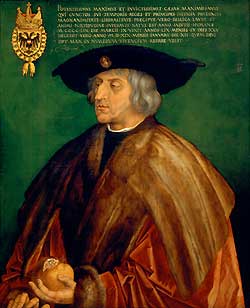

The Emperor Maximilian I (1459-1519), one of the most famous figures in European history, lived at a time of violent change, which was impressively symbolized in his character and life. He was virtually an embodiment of the spiritual situation of that epoch: a man of medieval, chivalrous ideals, and at the same time a man of the new age in his patronage of science, humanism and the arts.
In 1477 the young Maximilian was married to Maria of Burgundy, the daughter and heiress of Charles the Bold. Burgundy was the last centre of medieval culture. At that most brilliant court in Europe Maximilian became acquainted with the most eminent artists, heard the works of Netherlands composers sung and played by the best musicians of the time. There his love of music developed into profound knowledge, and he gained the experience of music and musicians which he was later to put to such good use in the foundation of his own court musical establishment. This establishment was, deservedly, the object of widespread admiration. The music of Maximilian's court gave the decisive impulse to the dawning musical culture of Germany.
The contrasts of that transitional period are emphasized by a clear distinction between north and south: in Italy, the birthplace of the Renaissance, the spiritual transformation had taken place more completely than in the northern countries. The visual arts had cast off all 'Gothic' (considered at that time to be tantamount to barbaric) forms, had discovered secular impulses. This land was bound to appear to many, especially artists north of the Alps who still lived and worked largely in the spirit and forms of the middle ages, as a shining example. In order to point out the widely differing forms existing at the same time it is sufficient to mention a few of the foremost artists of that period: Adam Kraft, Tilman Riemenschneider, Mathis Nithart, known as Grünewald as representatives of the late Gothic spirit, while Leonardo da Vinci, Michelangelo and Raphael were at work in Italy. Albrecht Dürer, who was closely connected with Maximilian for a time, was the first German artist to make the new ideals his own, following several artistic pilgrimages to Italy. In music the different epochs were less clearly differentiated, but here, too, the two faces of art at that time are distinguishable. The composers of the generation of Isaac and Josquin went a way which led from the rhythmical and tonal diversity of the earlier Netherlands masters to the noble suavity of the classically polyphonic, imitative textures of the 16th century. It is noteworthy that although this change was brought about by Netherlands composers, they were all men who had lived in Italy, the land of the new art.
The outstanding composer of the circle around Maximilian was Heinrich Isaac. The Emperor had engaged this Flemish musician, who had previously been employed at the Medici court in Florence, as his court composer in 1495. Isaac was required to provide compositions, but he was permitted to continue living in Florence, and to keep up his contacts with other patrons. Naturally he had to visit the Imperial court from time to time at the Emperor I 's command. Isaac's musical versatility has often been praised. While he tended towards conservatism in tonal and harmonic respects, favoring harsh fifths and the complex rhythms of the early Netherlands masters, he was highly inventive in matters of form. A great deal of his instrumental music has survived.
The only personal pupil of Isaac known to us was Ludwig Senfl, who came from Zürich. When Isaac died Senfl succeeded him as court composer to Maximilian. While his songs aim at complete euphony, his instrumental pieces, in which he frequently set himself complex contrapuntal tasks, are reminiscent of the harsher tonal world of his teacher.
The Composers (and some others)
- Johannes de Cleve
- Paul Hofhaimer
- Hans Kugelmann
- Heinrich [Henricus] Isaac [Ysaac, Isaak], [Arrigo il Tedesco]
- Jakob Regnart
- Adam Rener
- Arnolt Schlick
- Ludwig Senfl
- Jacobus Vaet
Supplemental Materials
Poetry and Prose
Articles
Return to: The Research Periods